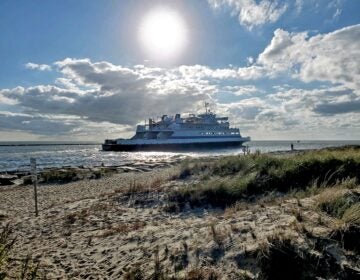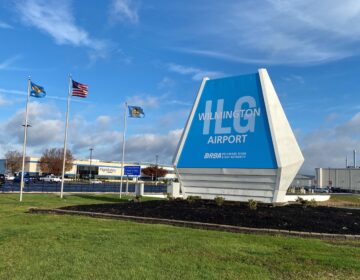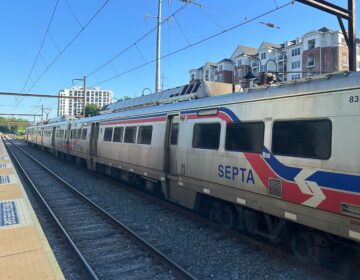PATCO realistic about funding challenge

May 4
By Seth Budick
For PlanPhilly
Speaking to an audience of transportation professionals last week, Cheryl Spicer, Assistant General Manager of PATCO, described her agency’s recent adoption of smart card technology, as well as plans for expanding service in southern New Jersey and on the Pennsylvania waterfront. Though it would serve an area with substantial potential for development and constitute the first major expansion of transit in Center City in years, new rail service on the Philadelphia side of the river could face difficult challenges in obtaining funding.
In her remarks to the Philadelphia Chapter of the Women’s Transportation Seminar at Camden’s Adventure Aquarium, Spicer focused largely on the challenges and benefits of the new smart card fare system which has achieved a 70 percent penetration rate among riders since its recent introduction. Her remarks were followed by an opportunity for the audience to study posters depicting the alternative alignments that are currently being considered for new transit service. In New Jersey, those include five alternatives for a new rail line to Camden and Gloucester counties, with possible extensions to Salem and Cumberland Counties (link to http://www.patconjexpansion.com/). Four of those proposals would involve new heavy rail lines (using technology similar to PATCO’s existing line) with direct service to Philadelphia via the Ben Franklin Bridge, while a fifth option would provide for a light rail line (similar to New Jersey Transit’s Riverline) terminating in Camden.
Separately, four alternative alignments were presented for new transit service in Philadelphia, three of which, PA-1, PA-1 Extended, and PA-2, were shown to the public in a series of open houses in January (link to http://www.patcopaexpansion.com/) (for descriptions of the alternatives, see below). In all cases, those alternatives include a new trolley line along the waterfront which would operate in the median of Columbus Blvd. and run between Pier 70 in the South (where Home Depot and Wal-Mart are currently located) and Penn Treaty Park in the North.
Besides those three possibilities, Spicer introduced an additional potential alignment, PA-3, which was generated in response to comments obtained during the ongoing Alternatives Analysis phase of the planning process. Like PA-1, PA-3 would extend service from the waterfront to Franklin Square with trolleys running at street level beneath the Ben Franklin Bridge. In addition to, or instead of looping around Franklin Square, however, it would extend the trolley south from the square, facilitating transfers to the multiple transit lines that stop at 8th and Market Streets. In this alternative, the trolley would continue south on 7th Street from Franklin Square, making a loop along 7th, 8th, Filbert and Cherry Streets.
With the aquarium’s sharks gliding by within a few feet of this poster presentation, it was difficult to miss the metaphor for the transit planning process. Competition for federal funding is currently fierce among transit agencies, particularly as cities around the country that have not traditionally invested in public transit are designing or opening new systems. PATCO in particular may find itself in a difficult position in the near future as it attempts to seek the funds from the Federal Transit Administration that will be necessary to proceed with both the New Jersey and Pennsylvania projects. Spicer suggested that PATCO would be likely to request a 50 percent federal funding share for both projects’ costs. Asked whether PATCO would be able justify the requests for funding for two projects in the same region, Spicer replied, “I think that it would have to be a very compelling case.” “It would need a lot of local support,” she added.
In addition to competing for federal money, the funding picture for any project in Philadelphia is likely to be complex with PATCO seeking a combination of federal, state, and local sources. While the New Jersey Department of Transportation has earmarked $250 million for the southern New Jersey expansion, no similar funds have yet been made available for new service in Philadelphia. Spicer cited figures of $700-$800 million for the Philadelphia alternatives, though that number will vary depending on the complexity of the project. The estimates for the New Jersey expansion were put at $1.8-2 billion “and growing.”
In the Alternatives Analysis phase of the planning process, PATCO is currently assessing costs, benefits, and community support in order to select a Locally Preferred Alternative which would then be submitted to the FTA as part of a request for federal funds. According to the timeline available on its website, that selection process should be completed in the first half of 2009.
With projected ridership being a key criterion for funding, a new line on the waterfront may find itself in a difficult chicken and egg scenario since transit expansion itself seems likely to serve as a catalyst for development. Nevertheless, PATCO is required to use current statistics in calculating ridership, according to Margaret Mund, a Senior Planner at Parsons Brinckerhoff who is working on the expansion plans.
Another interesting question is the degree to which PATCO itself might be involved in any development along the waterfront. Unlike SEPTA, which is restricted in its ability to participate in development that is not directly related to providing transportation services, (see article) PATCO is currently pursuing development opportunities at its New Jersey stations. The possibility of being involved in development in Philadelphia is “something that would clearly be part of the considerations” according to Spicer. “We would be very interested in joint development,” she added.
The answers to more detailed questions on the operation of any future service, such as the location of stations, is probably still a ways off according to Mund. In particular, since several of the Philadelphia alternatives allow for the possibility of running SEPTA vehicles all the way to the waterfront, Spicer was asked about the potential for collaboration between the agencies. “One thing I do understand is that SEPTA has a full plate,” she said, but then added that PATCO is “keeping the lines of communication open” and is “looking for opportunities to work together.”
Description of Philadelphia alternatives:
All of the Philadelphia alternatives involve running trolleys along the median of Columbus Blvd. between Pier 70 and Penn Treaty Park. Their key differences are in how they would cross I-95 and integrate with the rest of the SEPTA and PATCO systems. All of these alternatives also allow for extensions south to the Navy Yard as well as a short loop at Spring Garden St. for transfer to SEPTA’s Market-Frankford line.
PA-1: The trolley would cross under I-95 roughly at the level of Race St. and run, at street level, underneath the Ben Franklin Bridge to a loop around Franklin Square, allowing transfers to the existing PATCO line at an existing station which is currently closed.
PA-1 Extended: Similar to PA-1, but with trolleys continuing past Franklin Square, at street level, along 7th and Cherry Streets before descending into a tunnel near 9th and Arch Streets. The trolley would continue underground along Arch St. to Juniper St. where it would integrate with SEPTA’s existing Subway-Surface Lines.
PA-2: Would extend SEPTA’s Subway-Surface Lines down Market Street, either underground, or at street level, with trolleys crossing over I-95 to reach the waterfront.
PA-3: Similar to PA-1, but instead of, or in addition to, looping around Franklin Square, it would extend the trolley, at street level, from the square, heading south on 7th Street and making a small loop on 7th, 8th, Filbert and Cherry Streets. This alternative would also provide transfers to SEPTA lines and the existing PATCO line at 8th and Market Streets.
Contact the reporter at sbudick@gmail.com
WHYY is your source for fact-based, in-depth journalism and information. As a nonprofit organization, we rely on financial support from readers like you. Please give today.






